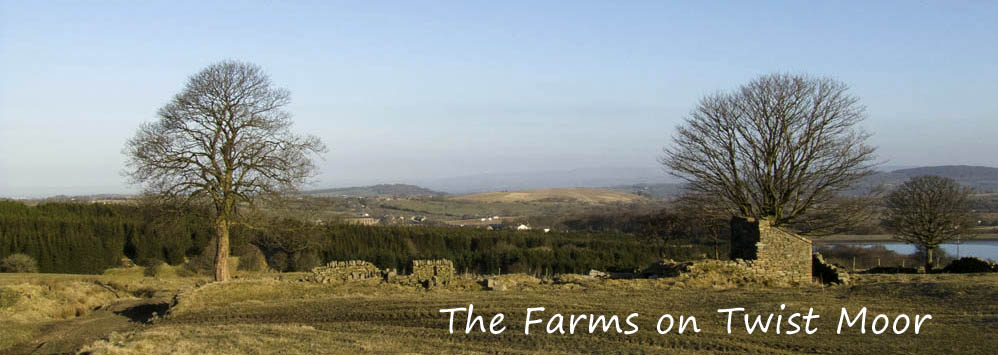 |
There are twelve farms to see in this group. They are situated to the north and north eastern of the moor stretching from Twist Moor Lane, (Withnell end) round and past Abbey Village. Most of them are quite remote. This walk is not suitable for large dogs (unless they are very agile) for the stiles are high and not at all dog friendly. There is a reason for that - the area is an important centre for sheep breeding and grazing. If you do take your dog please keep it under control and on a lead at all times. There are many old walled lanes and stone walls on the moor. I am putting the farms on this page in the order they appear in the book. The directions in the book for this walk are difficult to follow, and doesn't visit all the farms ie Tower View, The Oaks, Mosscrop's and Twist Moor House - though each was visible. I did make a detour and visited Tower View and The Oaks. |
|
A link to the route stated in the book is to the right Starting Point - Abbey Village |
|
Aushaw's (SD647217) |
|
Quite a substantial farm. The ruins are easily visible covering a large area. The view to Rake reservoir is wonderful. |
||
| Left: this is the old walled track into Aushaw's. To the right are great views across Rake reservoir and to Pendle Hill | ||
| The ruins of Aushaw's. Rake reservoir is below | ||
| Another view of Aushaw's ruins. |
Looking easterly towards Darwen Tower, this view gives an idea of the size of Aushaw's. It's occupiers farmed 6 acres
|
|
| Grouse Cottage (SD646216) | |
The cottage was still inhabited in the 1950s. A typical long house with lovely views. The toilet block still stands, though the roof now has missing slates. Oddly there is one room with no entrance. Away from the outhouse embedded in a wall, are two old rails, which probably supported a sink or tank of some sort. There is also what appears to be a section of an old metal downspout still in situ, and from which we know that some parts of the cottage, probably doors, gutters and window frames were painted green. In January of 2021 I was sent several photos of Grouse Cottage (and permission to use them) by Debbie Blacklidge. Debbie's Mum was Dorothy Bennett. Debbie also sent me a photo of Botany Bay Farm and another of Ratten Clough. Her family was the last family to live at Grouse Cottage and I am very grateful that she has let me publish them here. Her photo's appear first - followed by photographs of the ruins as they are now. |
|
 |
|
| Grouse Cottage in the early 1950s. | (Courtesy of Debbie Blacklidge 2021) |
 |
|
| Grouse Cottage - probably mid 1950s. The flue from the outhouse has been removed, as has one of the chimney stacks. The walls have also been painted (or whitewashed as they often called it then). The downspouts and doors were probably green (see pics below). There is also a dog just to the right of the outhouse door. | (Courtesy of Debbie Blacklidge 2021) |
 |
|
| Taken slightly earlier than the photo above - winters in the early 1950s could be quite harsh on the moors. Also note the person in the porch doorway - probably Mrs Sarah Bennett | (Courtesy of Debbie Blacklidge 2021) |
 |
|
| The rear of Grouse Cottage taken on the same day as the pic above - a distant Withnell can be seen in the distance. The lean to on the side of the house is pretty much all that remains of Grouse Cottage | (Courtesy of Debbie Blacklidge 2021) |
 |
|
| Sarah and James Bennett (James enjoying his pipe) and their daughter Dorothy ( Dorothy is the mother of Debbie who has let me use her photo's) enjoying a summers evening and taking in the wonderful views, as they probably did countless times before they left Grouse Cottage. | (Courtesy of Debbie Blacklidge 2021) |
 |
|
1951 - Dorothy Bennett Dorothy and her Mum and Dad, awoke one winter's morning to find several donkeys wandering in the snow outside. It was a little surprising because they didn't own any donkeys! Dorothy's Dad, Jimmy, walked to the closest farm, brought back food and water for them and rang the RSPCA. It turns out they were Blackpool donkeys that had sadly just been dumped there after the season ended. They were collected after a few days and taken to safety. |
(Courtesy of Debbie Blacklidge 2021) |
 |
|
| James Bennett and his dog Sam with the donkeys | Courtesy of Debbie Blacklidge 2021 |
 |
|
| Dorothy with one of the donkeys. | |
| Grouse Cottage - the building pictured is all that remains of the cottage. These buildings can be seen in the photos above | |
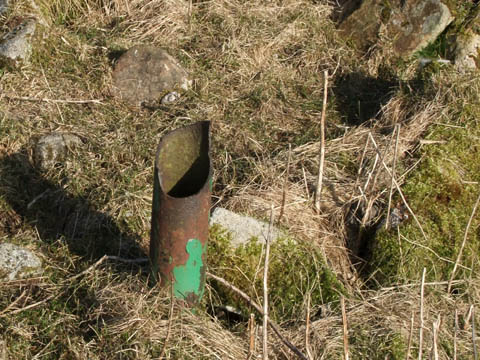 |
||
| The embedded rails | ...and the old downspout |
| The view looking NE - great location | ||
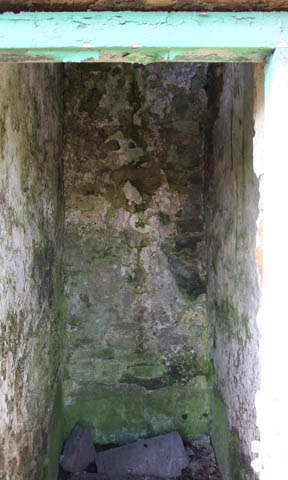 |
||
| This is the old toilet block. As can be seen by the slate on the floor, the roof is starting to give. Also, the green paint on the door frame confirms that the house had green frames/gutters, and the walls were probably whitewashed. | ||
| Grouse Cottage from Millstone Edge | ||
| Scott Hall (SD646214) | ||
| Scott Hall was not a large building, and little remains apart from rubble that is slowly being covered with moss and grass, and the well | ||
| The solitary sycamore that marks the location of Scott Hall | ||
| Scott Hall and the view to the west | ||
| Lovely vista from Scott Hall | ||
| Pope's (SD644213) | ||
| Pope's was built in an idyllic location at the foot of Millstone Edge, and alongside a stream that provided its water supply. | ||
| A corner stone and supporting wall survive and the layout can be made out from the fallen stones | ||
| Taken from above the ruins, the stream runs in the little channel beyond the house | This is an out building at Pope's - probably the loo. If it was it certainly had a good view from it | |
| The view to the north - its layout easy to discern. | ||
| Leaving Pope's on the moor side of the fence I came across this - though it didn't seem to worry the sheep. Skull aside, this is a typical view of what Twist Moor has looked like for hundreds of years. | ||
| Tower View (SD646211) | ||
Tower View was one of the last of the farmhouses to be built and was square shaped. The ruins are clear of undergrowth and offer the visitor an idea of its layout. There is no sycamore to help you locate Tower View, though there is a large upended railway sleeper that can act as a guide. The book takes you on the moor side of the fence from Pope's to view Tower View, but the results are not great as the two photographs below testify. |
||
| Tower View | Tower View | |
| Far better to leave Pope's by returning over the stile and then turning right and going directly to Tower View. | ||
| Tower View was built on a small rise, which would certainly have kept it dry. This view looking westerly to Brinscall Moor, shows the considerable amount of stonework still visible. Its pond is still discernable over by the fence, though much filled with reed/grass | ||
| The Oaks (SD647211 | ||
| By far the largest and best preserved of the Twist Moor ruins, The Oaks still has window sills still in place and the stonework of the lower walls still standing. It is very close to Tower View | ||
| Approaching The Oaks from Tower View |
| Looking North East, and the sycamore of Scott Hall can be seen through the window in the distance. Note the excellent condition of the quoins on each corner |
Standing on the highest part of The Oaks ruins, this is the view to the north east, and the sycamore to the left marks the location of Scott Hal
|
| Mosscrop's (SD649210) |
| Situated some half mile away across Rake Brook, the book merely points out the location, but doesn't visit it. As a result I will return and get photographs and add them to the site at a later date. NOTE I have now visited this farm when I walked the Roddlesworth & Calf Hey group. However, as the farm is in this section of the book, I have added photos below |
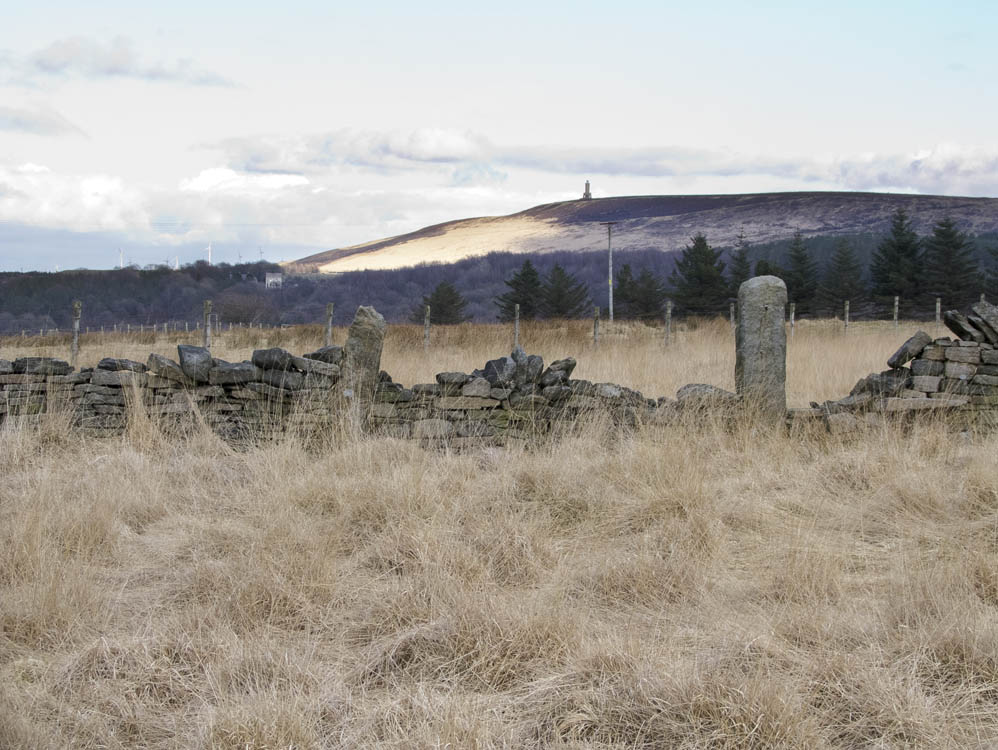 |
Stoned up gateway to Mosscrop's. Look for these - as a guide to the farm
|
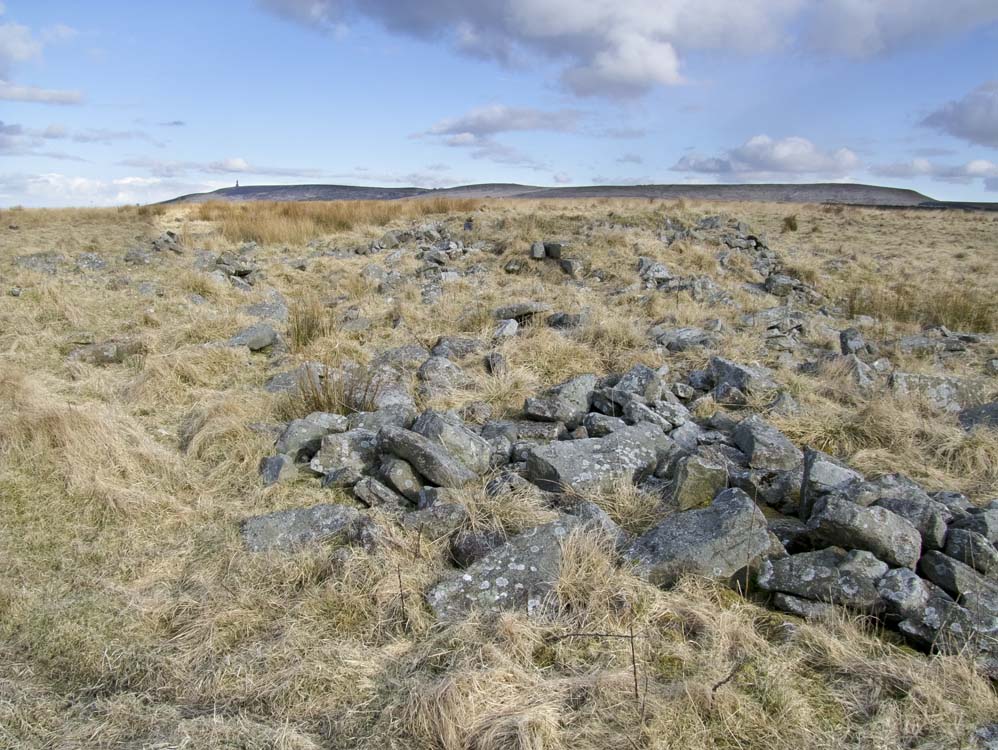 |
Plenty of rubble at this exposed site
|
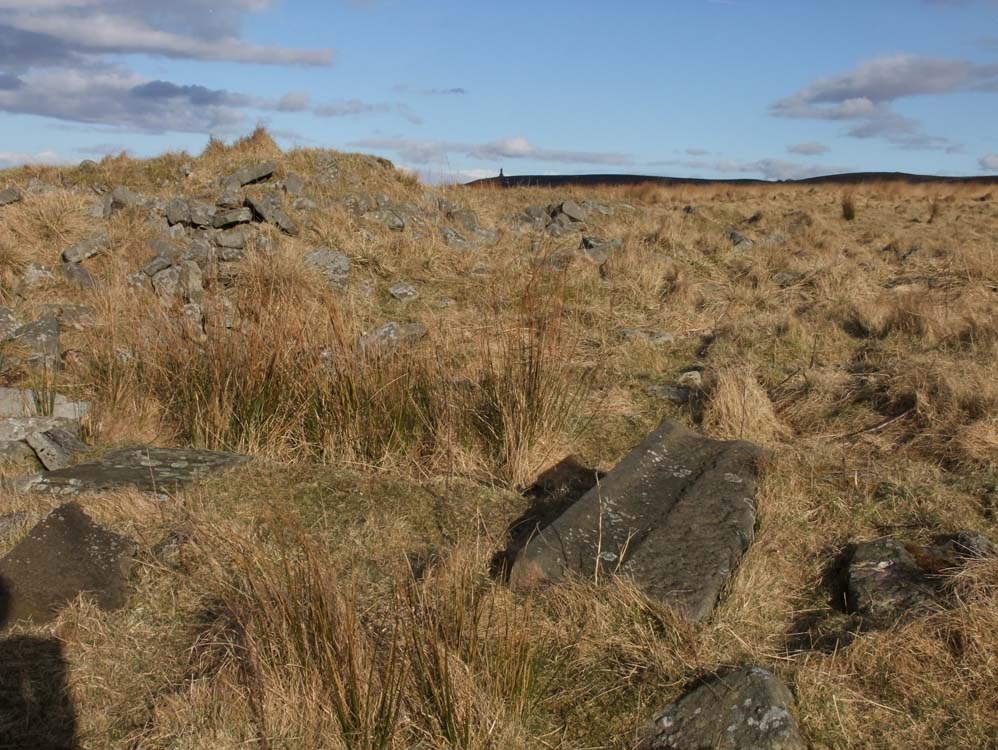 |
There are also some more interesting stones such as this above, with a carved channel in it.
|
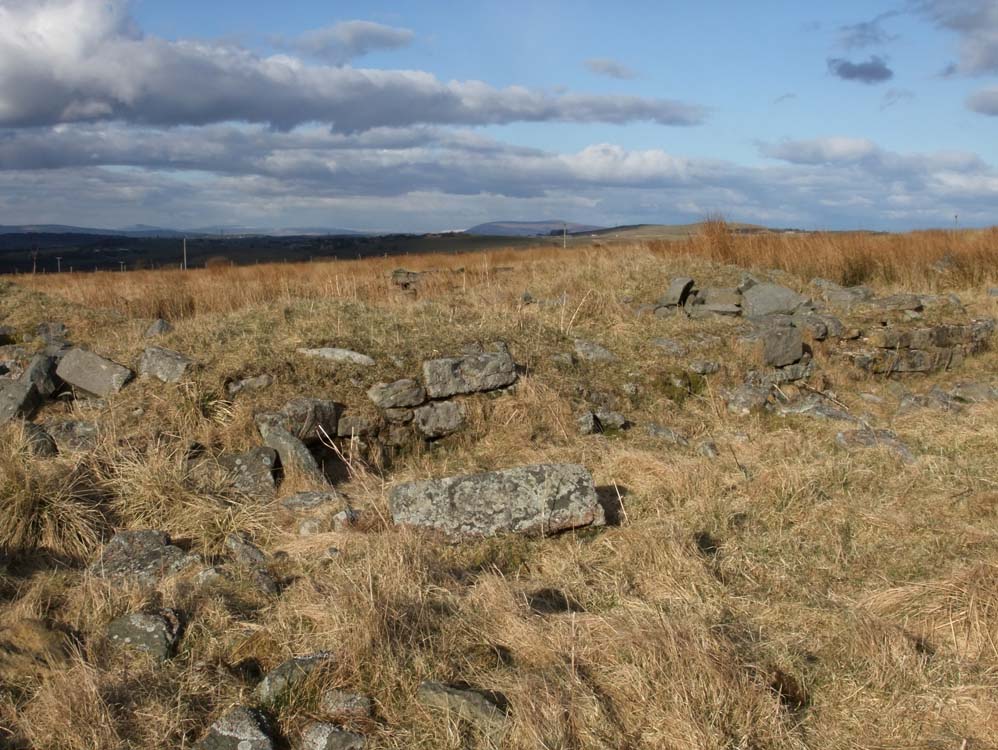 |
There is also walls and foundations to view
|
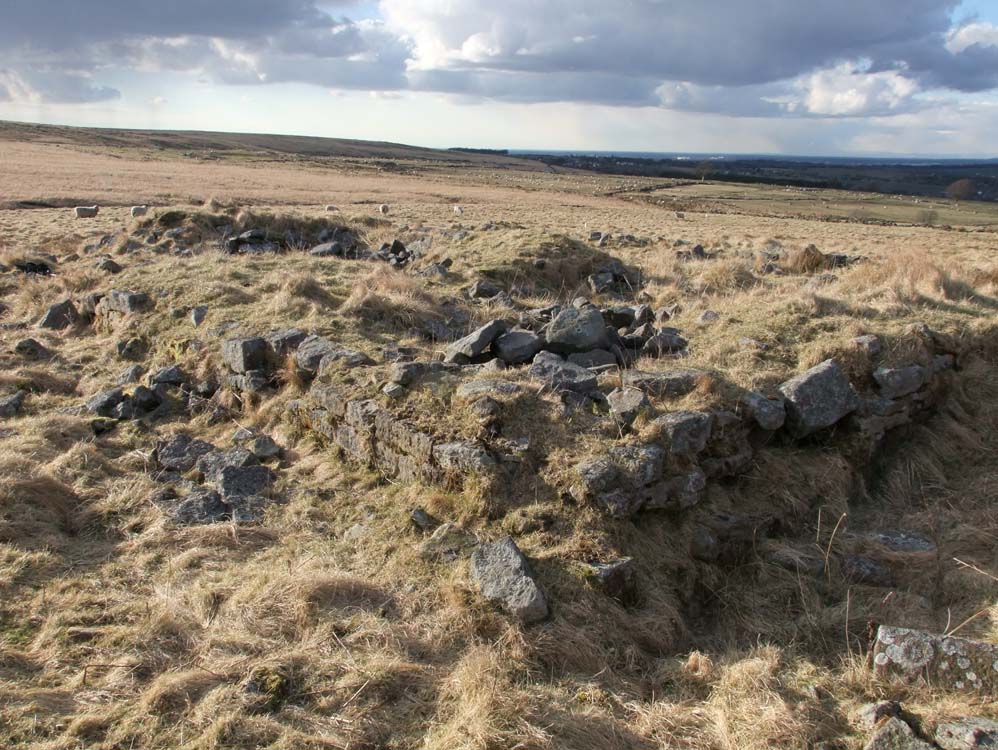 |
| An excellent view of the coursework and a great view of the farms position and isolation |
| Dale Fold (SD644217) |
| Little remains of Dale Fold except a flat area of raised land and a small embankment that was the surrounding wall and a single, very old gatepost. However, it was a large property with a bar, cottage and farmhouse. |
The old gatepost that marks the entrance to Dale Fold, and the land behind, which was its location After leaving Dale Fold, you need to cross Rushy Brook, and as the photo below shows - it can rush! (SD643213) |
| The power of water - Rushy Brook has swept this bridge aside |
| Hillock (SD639218) |
| Hillock is some way from Dale Fold, having to walk up and around Central Quarry, Withnell. As you descend a small rectangular lodge appears on the right and shortly after you come to the ruin if Hillock. Never a large building there is little to see here as grass and undergrowth are taking over. |
| The ruins of Hillock |
| After leaving Hillock Whave Gate is our next farm to visit, but not before passing a group of cottages that Ramsden's has been turned into. Ramsden's was an original long house. |
The cottages that was Ramsdens - perhaps if things had been different many of the farms we have visited would be similar to these. If only.....
|
| Whave Gate (SD636218) |
| Buried rubble is all that remains. Not at all noticeable unless looking for it, Whave Gate has all but disappeared |
| The site of Whave Gate which is on Twist Moor Lane |
| Whave Gate and Norcross Farm through the trees. |
Abbey Village from near Twist Moor Lane
|
On the way to our next farm, Snape's, we have to walk along the old pre-turnpike road and pass...
|
| ...Wood's Fold, another long house that has survived, and has made a beautiful modern home. |
| Snape's (SD644218) |
| The penultimate farm of the group, and easy to miss. Another case of undergrowth getting the upper hand. |
| Snape's is to the right after passing Wood's Fold. |
| This is close to the ruins |
| The ruins of Snape's. It is very tranquil now, very silent. A lovely spot. |
| Twist Moor House (SD645217) | ||
| This was another of the later house to be erected, the three hawthorn bushes giving away its location. This too, is another of the farms that are not directly visited, so I will also be revisiting this too | ||
| Three hawthorn bushes mark the site of Twist Moor House. This too, was one of the later houses to be built | ||
| This is the pre-turnpike road leading to the present day A675 |
